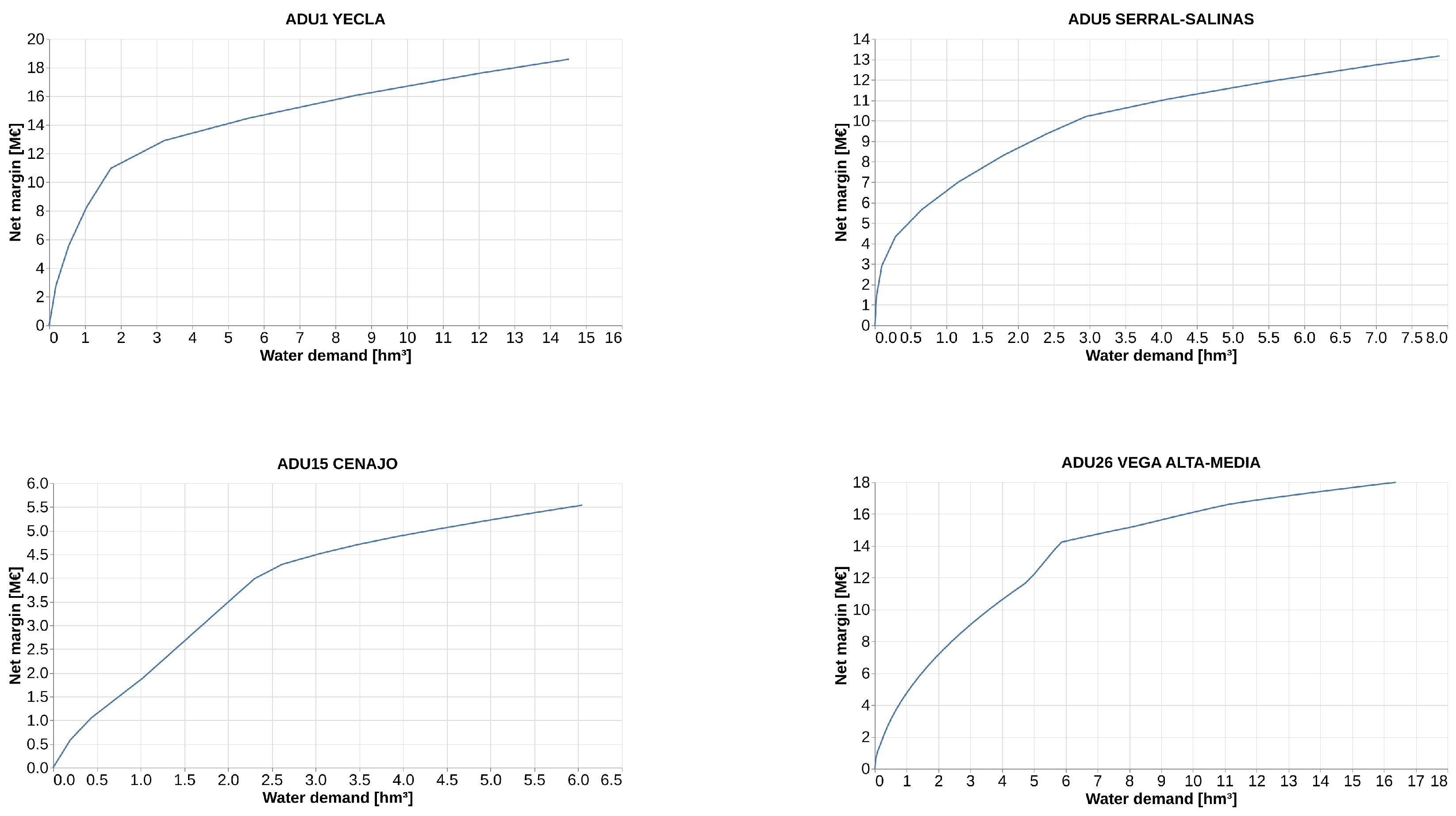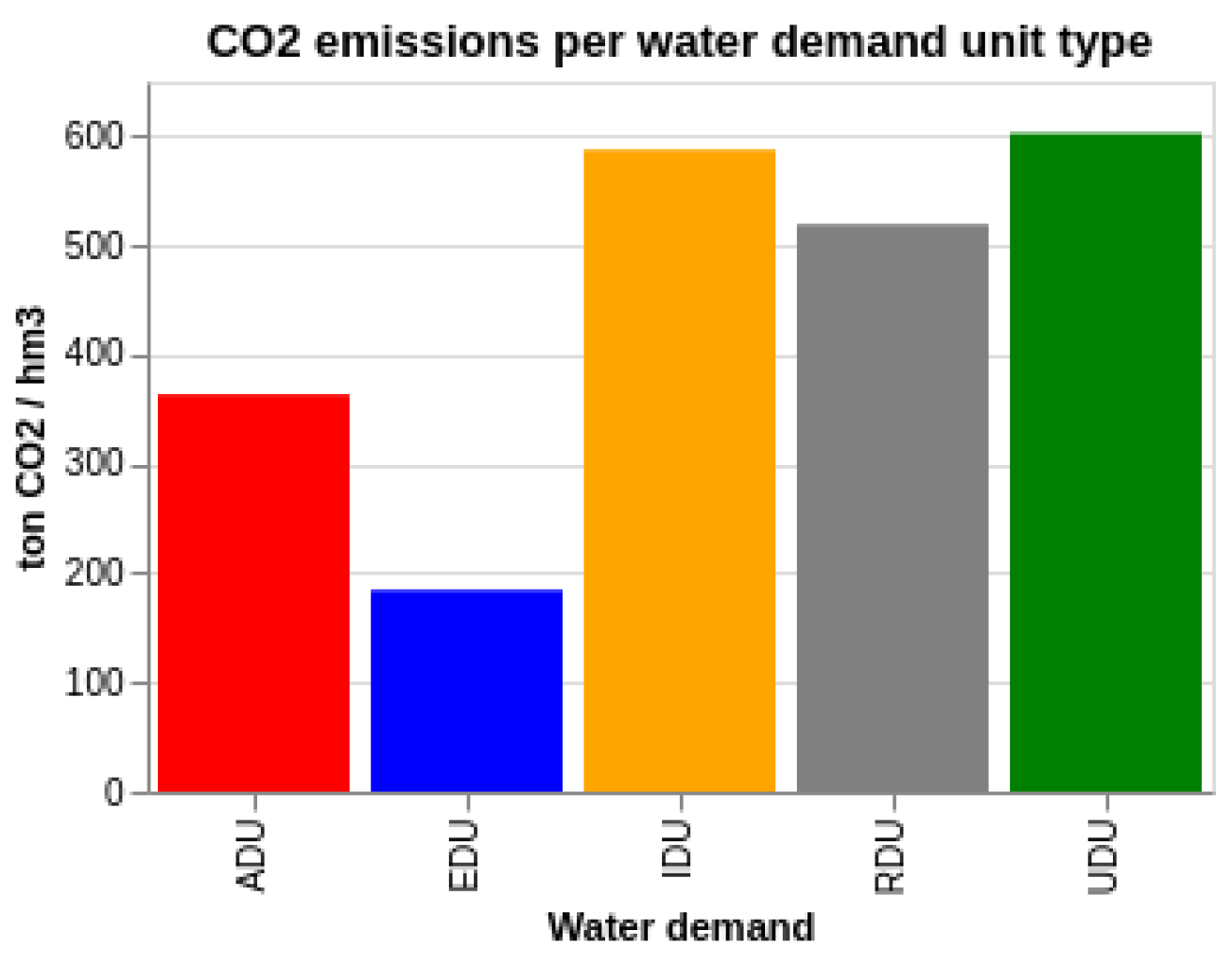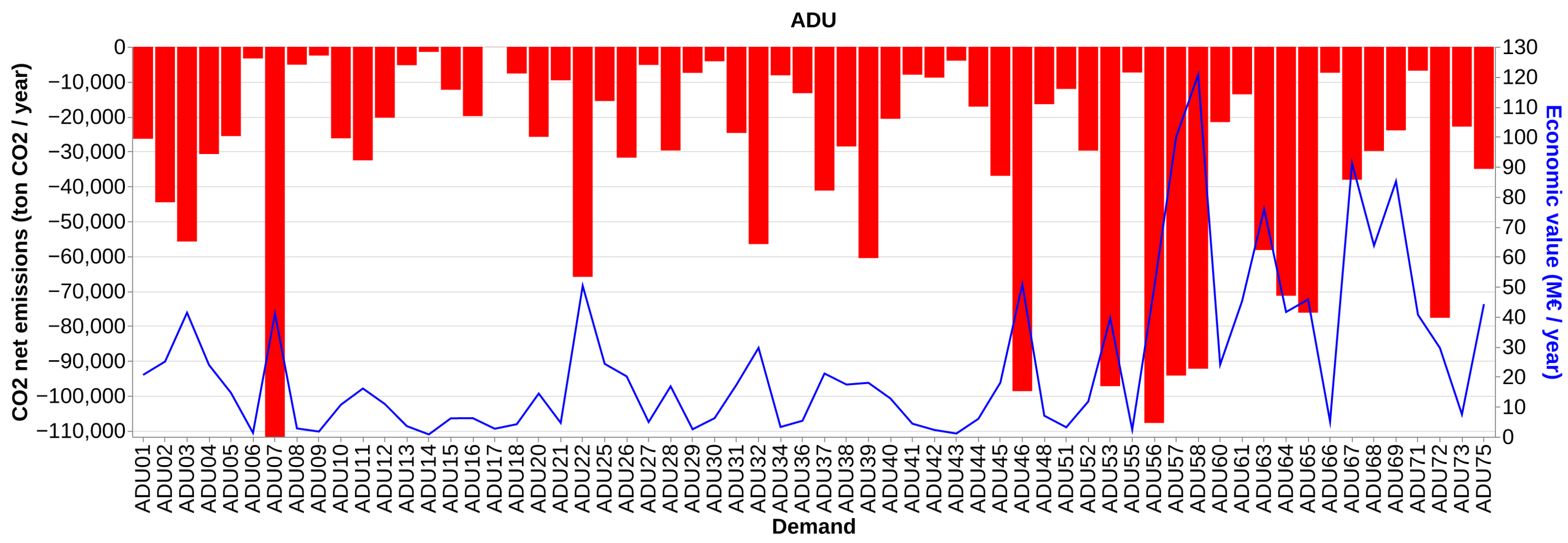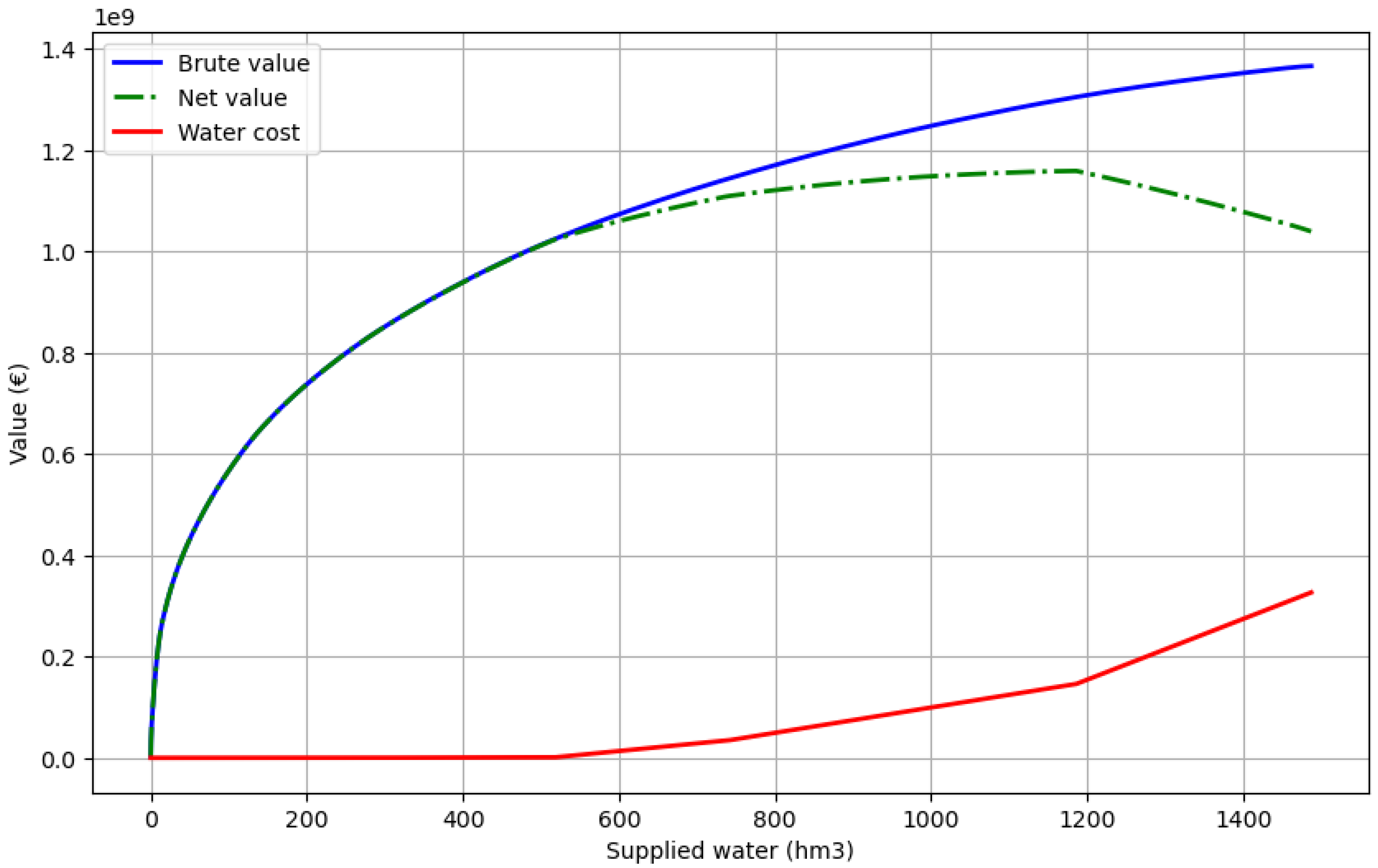Integrating CO2 Emissions and Economic Value Modeling for Sustainable Water Management: Insights from the Segura River Basin
Abstract
1. Introduction
2. Literature Review
2.1. CO2 Emissions Linked to Water Demand: Sectoral Impacts and Sources
2.2. Economic Value Associated with Water Demand
3. Materials and Methods
3.1. Study Area: Segura River Basin
3.1.1. Water Sources
- Surface water: Sourced primarily from the Segura River and its tributaries, surface water is vital for agricultural, urban and environmental uses. However, its availability is highly variable, affecting reliability, especially during dry years. Reservoirs throughout the basin help mitigate these fluctuations by storing water during wetter periods [48].
- Groundwater: Groundwater serves as a crucial resource, offering a more consistent supply compared to surface water. Over-extraction, however, has led to issues such as saline intrusion and aquifer depletion, intensifying the focus on sustainably managing groundwater extraction rates.
- Transferred water: The Tagus–Segura interbasin transfer (TST) channels water from the Tagus river basin to support agricultural and urban demands. While essential for balancing local shortages, the TST is subject to regulatory and environmental constraints in the donor basin, leading to potential variability in transferred volumes [49].
- Reclaimed water: Increasingly important as an alternative source, reclaimed water from wastewater treatment plants is primarily used for irrigation in agriculture and golf courses. It alleviates pressure on conventional sources and supports non-potable uses, with treatment standards ensuring safety and reliability for irrigation purposes.
- Desalinated water: Desalinated water provides a consistent supply independent of climatic conditions. However, desalination is energy-intensive, resulting in higher CO2 emissions compared to other sources. Despite this, desalinated water remains a key backup supply during extreme droughts, enhancing the basin’s resilience [2].
3.1.2. Water Demand Sectors and Units
- Agricultural Demand Units: Accounting for the largest water use, the agricultural sector is organized into 73 agricultural demand units (ADUs). Each ADU represents a designated irrigated area with common characteristics, such as irrigation methods, geographic location and shared water sources. These units are critical for optimizing water distribution for high-value crop irrigation.
- Industrial Demand Units: Industrial water demand is divided into seven industrial demand units, reflecting the spatial distribution of industrial activities, including agro-food industries and wineries.
- Urban Demand Units: Urban water use encompasses 14 urban demand units (UDUs). These units serve major population centers such as Murcia and Cartagena.
- Recreational Demand Units: The recreational sector, primarily golf courses, represents a notable water demand due to the region’s tourism prominence. Projected growth in this sector underscores the importance of efficient reclaimed water use and adaptive management to meet future demands sustainably amid increasing climate pressures.
- Environmental Demand Units: Environmental demand units aim to preserve key ecosystems, particularly wetlands within the basin. Specific water allocations are designated to maintain ecological balance and biodiversity, especially during droughts, ensuring a continuous water supply to vulnerable habitats.
3.2. CO2 Emissions Modeling for Water Demand Sectors in the Segura River Basin
3.2.1. Agricultural Water Use
3.2.2. Industrial Water Use
3.2.3. Urban Water Use
3.2.4. Recreational Water Use
3.2.5. Environmental Water Use
3.2.6. Water Source Emission Factors
3.3. Economic Value Modeling
3.3.1. Agricultural Water Use
3.3.2. Industrial Water Use
3.3.3. Urban Water Use
- is the price elasticity of demand,
- D is the total water demand of the UDU (m3/year),
- Q is the volume of water supplied to the UDU (m3/year),
- is the average cost of water in the Segura Basin.
3.3.4. Recreational Water Use
3.3.5. Environmental Water Use
4. Results
4.1. Water Origin Distribution and Carbon Footprint Across Demands
4.2. CO2 Emissions and Economic Outcomes in the Water Demand Units
4.3. Environmental and Economic Efficiency Metrics
5. Conclusions
Author Contributions
Funding
Data Availability Statement
Acknowledgments
Conflicts of Interest
Abbreviations
| ADU | Agricultural Demand Unit |
| CDTI | Centro para el Desarrollo Tecnológico y la Innovación |
| CHS | Confederación Hidrográfica del Segura |
| EDU | Environmental Demand Unit |
| GVA | Gross Value Added |
| IDU | Industrial Demand Unit |
| LCA | Life Cycle Assessment |
| NSI | National Statistics Institute (Spain) |
| RDU | Recreational Demand Unit |
| TST | Tagus–Segura Transfer |
| UDU | Urban Demand Unit |
References
- Ricart, S.; Villar-Navascués, R. Extending natural limits to address water scarcity? The role of non-conventional water fluxes in climate change adaptation capacity: A review. Sustainability 2021, 13, 2473. [Google Scholar] [CrossRef]
- Martínez-Alvarez, V.; González-Ortega, M.J.; Martin-Gorriz, B.; Soto-García, M.; Maestre-Valero, J.F. The use of desalinated seawater for crop irrigation in the Segura River Basin (south-eastern Spain). Desalination 2017, 422, 153–165. [Google Scholar] [CrossRef]
- Borrego-Marín, M.; Berbel, J. Cost-benefit analysis of irrigation modernization in Guadalquivir River Basin. Agric. Water Manag. 2019, 210, 64–72. [Google Scholar] [CrossRef]
- Ortuño, A.; Casares, J.; Calero, P.; Flor, M.; Iborra, V. A Socio-Economic and Environmental Analysis of the Implementation of Sustainable Urban Drainage Systems in Vega Baja—Alicante (Spain). Water 2022, 14, 902. [Google Scholar] [CrossRef]
- Haro-Monteagudo, D.; Palazón, L.; Beguería, S. Long-term sustainability of large water resource systems under climate change: A cascade modeling approach. J. Hydrol. 2020, 581, 124412. [Google Scholar] [CrossRef]
- Senent-Aparicio, J.; Pérez-Sánchez, J.; Carrillo-García, J.; Soto, J. Using SWAT and Fuzzy TOPSIS to assess the impact of climate change in the headwaters of the Segura River Basin (SE Spain). Water 2017, 9, 149. [Google Scholar] [CrossRef]
- Vargas, E.M.; Lopez-Gunn, E.; Huelva, G.; Estrela, T. Adopting the framework of river basin planning for climate change adaptation in Spain. In Adaptation to Climate Change Through Water Resources Management; Stucker, S., Lopez-Gunn, E., Eds.; Routledge: Abingdon, UK, 2014; pp. 353–373. [Google Scholar] [CrossRef]
- Liu, B.; Wang, Z.; Tian, M.; Yang, X.; Chan, C.N.; Chen, S.; Yang, Q.; Ran, L. Basin-Scale CO2 Emissions From the East River in South China: Importance of Small Rivers, Human Impacts and Monsoons. J. Geophys. Res. Biogeosci. 2023, 128, e2022JG007291. [Google Scholar] [CrossRef]
- Zhang, W.; Li, H.; Xiao, Q.; Li, X. Urban rivers are hotspots of riverine greenhouse gas (N2O, CH4, CO2) emissions in the mixed-landscape chaohu lake basin. Water Res. 2021, 189, 116624. [Google Scholar] [CrossRef]
- Panique-Casso, D.G.; Goethals, P.; Ho, L. Modeling greenhouse gas emissions from riverine systems: A review. Water Res. 2024, 250, 121012. [Google Scholar] [CrossRef]
- Alamanos, A.; Garcia, J.A. Optimization Examples for Water Allocation, Energy, Carbon Emissions, and Costs. Encyclopedia 2024, 4, 295–312. [Google Scholar] [CrossRef]
- Tang, W.; Yang, H.; Wang, W.; Chen, D.; Xu, C.; Zha, Q.; Hu, X. Effects of water allocation process on greenhouse gas emissions in drip-irrigated apple orchards on the Loess Plateau, China. Agric. Ecosyst. Environ. 2022, 338, 108077. [Google Scholar] [CrossRef]
- Feng, M.; Chen, Y.; Li, Z.; Duan, W.; Zhu, Z.; Liu, Y.; Zhou, Y. Optimisation model for sustainable agricultural development based on water-energy-food nexus and CO2 emissions: A case study in Tarim river basin. Energy Convers. Manag. 2024, 303, 118174. [Google Scholar] [CrossRef]
- Escriva-Bou, A.; Lund, J.R.; Pulido-Velazquez, M. Saving Energy From Urban Water Demand Management. Water Resour. Res. 2018, 54, 4265–4276. [Google Scholar] [CrossRef]
- Ma, J.; Yin, Z.; Cai, J. Efficiency of urban water supply under carbon emission constraints in China. Sustain. Cities Soc. 2022, 85, 104040. [Google Scholar] [CrossRef]
- Rothausen, S.G.S.A.; Conway, D. Greenhouse-gas emissions from energy use in the water sector. Nat. Clim. Change 2011, 1, 210–219. [Google Scholar] [CrossRef]
- Lu, W.C. Industrial water-use technical efficiency and potential reduction of CO2 emissions: Evidence from industry-level data. Carbon Manag. 2019, 10, 513–522. [Google Scholar] [CrossRef]
- Bartlett, M.D.; James, I.T. A model of greenhouse gas emissions from the management of turf on two golf courses. Sci. Total Environ. 2011, 409, 1357–1367. [Google Scholar] [CrossRef]
- Bekken, M.A.H.; Soldat, D.J. Estimated energy use and greenhouse gas emissions associated with golf course turfgrass maintenance in the Northern USA. Int. Turfgrass Soc. Res. J. 2022, 14, 58–75. [Google Scholar] [CrossRef]
- Zou, J.; Ziegler, A.D.; Chen, D.; McNicol, G.; Ciais, P.; Jiang, X.; Zeng, Z. Rewetting global wetlands effectively reduces major greenhouse gas emissions. Nat. Geosci. 2022, 15, 627–632. [Google Scholar] [CrossRef]
- Soto-García, M.; Martin-Gorriz, B.; García-Bastida, P.A.; Alcon, F.; Martínez-Alvarez, V. Energy consumption for crop irrigation in a semiarid climate (south-eastern Spain). Energy 2013, 55, 1084–1093. [Google Scholar] [CrossRef]
- Martin-Gorriz, B.; Martínez-Alvarez, V.; Maestre-Valero, J.F.; Gallego-Elvira, B. Influence of the Water Source on the Carbon Footprint of Irrigated Agriculture: A Regional Study in South-Eastern Spain. Agronomy 2021, 11, 351. [Google Scholar] [CrossRef]
- Quevauviller, P.; Barceló, D.; Beniston, M.; Djordjevic, S.; Harding, R.J.; Iglesias, A.; Ludwig, R.; Navarra, A.; Navarro Ortega, A.; Mark, O.; et al. Integration of research advances in modelling and monitoring in support of WFD river basin management planning in the context of climate change. Sci. Total Environ. 2012, 440, 167–177. [Google Scholar] [CrossRef] [PubMed]
- Huntjens, P.; Pahl-Wostl, C.; Grin, J. Climate change adaptation in European river basins. Reg. Environ. Change 2010, 10, 263–284. [Google Scholar] [CrossRef]
- Grindlay, A.L.; Zamorano, M.; Rodríguez, M.I.; Molero, E.; Urrea, M.A. Implementation of the European Water Framework Directive: Integration of hydrological and regional planning at the Segura River Basin, southeast Spain. Land Use Policy 2011, 28, 242–256. [Google Scholar] [CrossRef]
- Pellicer-Martínez, F.; Martínez-Paz, J.M. Climate change effects on the hydrology of the headwaters of the Tagus River: Implications for the management of the Tagus–Segura transfer. Hydrol. Earth Syst. Sci. 2018, 22, 6473–6491. [Google Scholar] [CrossRef]
- Grafton, R.Q.; Chu, L.; Wyrwoll, P. The paradox of water pricing: Dichotomies, dilemmas, and decisions. Oxf. Rev. Econ. Policy 2020, 36, 86–107. [Google Scholar] [CrossRef]
- Young, R.A. Determining the Economic Value of Water: Concepts and Methods; RFF Press: Washingtong, DC, USA, 2021. [Google Scholar]
- Harou, J.J.; Pulido-Velazquez, M.; Rosenberg, D.E.; Medellín-Azuara, J.; Lund, J.R.; Howitt, R.E. Hydro-economic models: Concepts, design, applications, and future prospects. J. Hydrol. 2009, 375, 627–643. [Google Scholar] [CrossRef]
- Garrick, D.; Hrachowitz, M.; Sriwongsitanon, N.; Fenicia, F.; Gharari, S.; Savenije, H.H.G. Managing water allocation trade-offs in a river basin: Lessons from the Murray-Darling and Colorado systems. Water Resour. Res. 2017, 53, 261–279. [Google Scholar] [CrossRef]
- Ward, F.A.; Pulido-Velazquez, M. Water conservation in irrigation can increase water use. Proc. Natl. Acad. Sci. USA 2008, 105, 18215–18220. [Google Scholar] [CrossRef]
- Dagnino, M.; Ward, F.A. Economics of agricultural water conservation: Empirical analysis and policy implications. Water Resour. Dev. 2012, 28, 577–594. [Google Scholar] [CrossRef]
- Food of the United Nations (FAO). The State of the World’s Land and Water Resources for Food and Agriculture: Managing Systems at Risk; Routledge: London, UK, 2012. [Google Scholar] [CrossRef]
- Rothman, D.S. Measuring environmental values and sustainability in water allocation: A critical review of methods and concepts. J. Environ. Manag. 2000, 60, 203–216. [Google Scholar] [CrossRef]
- Gleick, P.H.; Allen, L.; Christian-Smith, J.; Cohen, M.J.; Cooley, H.; Heberger, M.; Morrison, J.; Palaniappan, M.; Schulte, P. The World’s Water Volume 8: The Biennial Report on Freshwater Resources; Island Press: Washington, DC, USA, 2014. [Google Scholar]
- Gleick, P.H. Water use. Annu. Rev. Environ. Resour. 2003, 28, 275–314. [Google Scholar] [CrossRef]
- Hanemann, W.M. The economic conception of water. In Water Crisis: Myth or Reality? CRC Press: London, UK, 2006; pp. 61–91. [Google Scholar]
- Renzetti, S. The Economics of Water Demands; Kluwer Academic Publishers: Boston, MA, USA, 2002. [Google Scholar] [CrossRef]
- Gössling, S.; Peeters, P.; Hall, C.M.; Ceron, J.P.; Dubois, G.; Lehmann, L.V.; Scott, D. Tourism and water use: Supply, demand, and security. An international review. Tour. Manag. 2012, 33, 1–15. [Google Scholar] [CrossRef]
- UNESCO. The United Nations World Water Development Report 2018: Nature-Based Solutions for Water; United Nations Educational, Scientific and Cultural Organization: Paris, France, 2018. [Google Scholar]
- Costanza, R.; d’Arge, R.; De Groot, R.; Farber, S.; Grasso, M.; Hannon, B.; Limburg, K.; Naeem, S.; O’neill, R.V.; Paruelo, J.; et al. The value of the world’s ecosystem services and natural capital. Nature 1997, 387, 253–260. [Google Scholar] [CrossRef]
- De Groot, R.; Brander, L.; Van Der Ploeg, S.; Costanza, R.; Bernard, F.; Braat, L.; Christie, M.; Crossman, N.; Ghermandi, A.; Hein, L.; et al. Global estimates of the value of ecosystems and their services in monetary units. Ecosyst. Serv. 2012, 1, 50–61. [Google Scholar] [CrossRef]
- Barbier, E.B.; Hacker, S.D.; Kennedy, C.; Koch, E.W.; Stier, A.C.; Silliman, B.R. The value of estuarine and coastal ecosystem services. Ecol. Monogr. 2011, 81, 169–193. [Google Scholar] [CrossRef]
- de Groot, R.S.; Blignaut, J.; van der Ploeg, S.; Aronson, J.; Elmqvist, T.; Farley, J. Benefits of investing in ecosystem restoration. Conserv. Biol. 2013, 27, 1286–1293. [Google Scholar] [CrossRef] [PubMed]
- Contreras, S.; Hunink, J. Water Accounting at the Basin Scale: Water Use and Supply (2000–2010) in the Segura River Basin Using the SEEA Framework. FutureWater Rep. 2015. [Google Scholar] [CrossRef]
- Zuluaga-Guerra, P.; Martinez-Fernandez, J. A Socio-Ecological Model of the Segura River Basin, Spain. Ecol. Model. 2023, 478, 110284. [Google Scholar] [CrossRef]
- Cañizares, A.; Cantos, J.; Castiñeira, C.B. The Effects of Climate Change on the Tagus–Segura Transfer: Diagnosis of the Water Balance in the Vega Baja del Segura (Alicante, Spain). Water 2023, 14, 2023. [Google Scholar] [CrossRef]
- Alhama, I.; García-Ros, G.; Alhama, F. Integrated Water Resources Management in the Basin of the Segura River (Southeast Spain); An Example of Adaptation to Drought Periods. Environ. Earth Sci. 2020, 79, 7. [Google Scholar] [CrossRef]
- Morote, A.; Hernández, M.; Rico, A. Interbasin Water Transfer Conflicts: The Case of the Tagus-Segura Aqueduct (Spain). Int. J. Hydrol. Sci. Technol. 2020, 10, 364–391. [Google Scholar] [CrossRef]
- del Segura, C.H. Hydrological Plan of the Segura River Basin 2015–2021; Ministry of Agriculture, Food, and Environment: Madrid, Spain, 2016.
- Guarín, A.; Martínez-Paz, J.M.; Pedreño, A. Water and carbon footprint reduction in irrigated agriculture: A case study in Southern Spain. J. Environ. Manag. 2021, 290, 112581. [Google Scholar] [CrossRef]
- Arunrat, N.; Sereenonchai, S.; Wang, C. Carbon footprint and predicting the impact of climate change on carbon sequestration ecosystem services of organic rice farming and conventional rice farming: A case study in Phichit province, Thailand. J. Environ. Manag. 2021, 289, 112458. [Google Scholar] [CrossRef]
- Wang, Z.B.; Wen, X.Y.; Zhang, H.L.; Lu, X.H.; Chen, F. Net energy yield and carbon footprint of summer corn under different N fertilizer rates in the North China Plain. J. Integr. Agric. 2015, 14, 1534–1541. [Google Scholar] [CrossRef]
- Cayambe, J. Quantification of Greenhouse Gas Emissions in Potato Production Systems for Consumption in Spain, Ecuador, and Peru. Ph.D. Thesis, Pontificia Universidad Católica del Ecuador, Quito, Ecuador, 2013. [Google Scholar] [CrossRef]
- Jumilla, F.V. The Eco-Responsability Initiative of Murcian Agriculture as a CO2 Sink: The LESSCO2 Brand. Available online: https://www.researchgate.net/profile/Micaela-Carvajal/publication/285295502_Absorcion_de_CO2_por_los_cultivos_mas_representativos_de_la_Region_de_Murcia/links/64ec801340289f7a0fbeb6b9/Absorcion-de-CO2-por-los-cultivos-mas-representativos-de-la-Region-de-Murcia.pdf (accessed on 22 November 2024).
- Biblioteca Virtual de Aragón. Available online: https://bibliotecavirtual.aragon.es/i18n/catalogo_imagenes/grupo.cmd?path=3707991 (accessed on 22 November 2024).
- Russo, V.; Strever, A.E.; Ponstein, H.J. Exploring sustainability potentials in vineyards through LCA? Evidence from farming practices in South Africa. Int. J. Life Cycle Assess. 2021, 26, 1374–1390. [Google Scholar] [CrossRef]
- Fotia, K.; Mehmeti, A.; Tsirogiannis, I.; Nanos, G.; Mamolos, A.P.; Malamos, N.; Barouchas, P.; Todorovic, M. LCA-Based Environmental Performance of Olive Cultivation in Northwestern Greece: From Rainfed to Irrigated through Conventional and Smart Crop Management Practices. Water 2021, 13, 1954. [Google Scholar] [CrossRef]
- National Statistics Institute (Instituto Nacional de Estadística) Atmospheric Emissions Account. Latest Data. Available online: https://www.ine.es/dyngs/INEbase/operacion.htm?c=Estadistica_C&cid=1254736176941&menu=ultiDatos&idp=1254735976603 (accessed on 22 November 2024).
- Santos, S.N.; Ivorra, A.G.; Gil, E.M.; Garcia, M.C. Cálculo de la huella de carbono del ciclo urbano del agua. La experiencia de Emuasa. Tecnoaqua 2016, 19, 58–65. Available online: http://www.tecnoaqua.es/media/uploads/noticias/documentos/articulo-tecnico-calculo-huella-carbono-ciclo-urbano-agua-emuasa-tecnoaqua-es.pdf (accessed on 22 November 2024).
- Guairacaja Yánez, K.M. Estimation of the Water and Carbon Footprints of Greenhouse Tomato Production in the Segura Basin; Universidad Politécnica de Madrid: Madrid, Spain, 2021. [Google Scholar]
- Alonso González, A. Evaluation of the Carbon and Economic Footprints of Water Resource Use in Spain: Analysis of the Segura and Guadalquivir Basins. Bachelor’s Thesis, Universidad Politécnica de Madrid, Madrid, Spain, 2020. [Google Scholar]
- Crespo, D.; Albiac, J.; Dinar, A.; Esteban, E.; Kahil, T. Integrating ecosystem benefits for sustainable water allocation in hydroeconomic modeling. PLoS ONE 2022, 17, e0267439. [Google Scholar] [CrossRef]
- Diaz, J.A.R.; Knox, J.W.; Weatherhead, E.K. Competing demands for irrigation water: Golf and agriculture in Spain. Irrig. Drain. 2007, 56, 541–549. [Google Scholar] [CrossRef]
- Sharma, B.; Rasul, G.; Chettri, N. The economic value of wetland ecosystem services: Evidence from the Koshi Tappu Wildlife Reserve, Nepal. Ecosyst. Serv. 2015, 12, 84–93. [Google Scholar] [CrossRef]










| Crop | Emissions Without Irrigation | Carbon Sequestration |
|---|---|---|
| (t CO2/ha·Year) | (t CO2/ha·Year) | |
| Winter cereals [51] | 1.754 | −12.857 |
| Rice [52] | 4.856 | −2.292 |
| Spring cereals [53] | 1.370 | −35.500 |
| Tubers [54] | 4.200 | −15.950 |
| Greenhouse horticulture [55] | 10.743 | −28.369 |
| Open-field horticulture [22] | 12.369 | −15.910 |
| Citrus fruits [22] | 8.243 | −25.560 |
| Fleshy-fruit trees [22] | 6.862 | −24.080 |
| Almond trees [56] | 12.030 | −22.240 |
| Wine vineyards [57] | 1.800 | −7.700 |
| Table grape vineyards [55] | 3.000 | −20.700 |
| Olive groves [58] | 4.011 | −16.700 |
| Industry Sector | IDU 1 | IDU 2 | IDU 3 | IDU 4 | IDU 5 | IDU 6 |
|---|---|---|---|---|---|---|
| Food | 66.13% | 62.08% | 42.02% | 37.76% | 20.80% | 29.03% |
| Textile | 4.99% | 2.11% | 1.26% | 2.30% | 19.60% | 0.68% |
| Wood | 1.72% | 5.55% | 2.95% | 4.98% | 9.76% | 1.99% |
| Chemical | 5.29% | 0.00% | 10.64% | 16.13% | 9.83% | 17.65% |
| Rubber | 10.59% | 18.84% | 5.42% | 7.04% | 12.21% | 5.55% |
| Metallurgy | 4.81% | 4.41% | 7.73% | 12.81% | 11.10% | 13.15% |
| Computer Products | 1.40% | 2.16% | 4.22% | 8.17% | 6.19% | 3.44% |
| Transport Equipment | 2.22% | 0.00% | 0.00% | 2.62% | 1.04% | 19.90% |
| Miscellaneous Manufacturing | 2.85% | 4.85% | 25.76% | 8.19% | 9.47% | 8.61% |
| IDU | IDU 1 | IDU 2 | IDU 3 | IDU 4 | IDU 5 | IDU 6 | IDU 7 |
|---|---|---|---|---|---|---|---|
| CO2 Emissions | 692.07 | 1211.85 | 372.82 | 478.39 | 799.35 | 386.52 | 16.89 |
| (kg CO2/m3) |
| Emissions Without Irrigation | CO2 Sequestration | Water Consumption | Emission Ratio | |
|---|---|---|---|---|
| (t CO2/Year) | (t CO2/Year) | (m3/Year) | (kg CO2/m3) | |
| Values | 184.3 | −28.14 | 225,440 | 0.6927 |
| Water Source Type | Specific Energy | CO2 Emissions |
|---|---|---|
| (kWh/m3) | (kg CO2/m3) | |
| Surface water | 0.06 | 0.021 |
| Groundwater | 0.90 | 0.319 |
| Reclaimed water | 0.78 | 0.276 |
| Transferred water | 1.21 | 0.429 |
| Desalinated water | 4.32 | 1.530 |
| Industrial Sector | Water Consumption |
|---|---|
| (m3/EUR 1000 GVA) | |
| Food | 13.3 |
| Textile | 22.8 |
| Wood | 14.5 |
| Chemical | 19.2 |
| Rubber | 2.9 |
| Metallurgy | 16.5 |
| Computer products | 1.1 |
| Transport equipment | 2.1 |
| Miscellaneous manufacturing | 4.0 |
| Sectors | Surface Water | Groundwater | Transferred Water | Reclaimed Water | Desalinated Water | Total | Deficit |
|---|---|---|---|---|---|---|---|
| Agricultural | 422 | 446 | 222 | 136 | 126 | 1352 | 193 |
| Urban | 66 | 9 | 100 | 0 | 63 | 238 | 0 |
| Industrial | 0 | 7 | 0 | 0 | 2 | 9 | 0 |
| Recreational | 0 | 4 | 0 | 5 | 2 | 11 | 0 |
| Environmental | 16 | 22 | 0 | 1 | 0 | 39 | 0 |
| Total | 504 | 488 | 322 | 142 | 193 | 1649 | 193 |
Disclaimer/Publisher’s Note: The statements, opinions and data contained in all publications are solely those of the individual author(s) and contributor(s) and not of MDPI and/or the editor(s). MDPI and/or the editor(s) disclaim responsibility for any injury to people or property resulting from any ideas, methods, instructions or products referred to in the content. |
© 2025 by the authors. Licensee MDPI, Basel, Switzerland. This article is an open access article distributed under the terms and conditions of the Creative Commons Attribution (CC BY) license (https://creativecommons.org/licenses/by/4.0/).
Share and Cite
Odriozola, J.; Flores, M.; Lainez-Oyuela, W.; Maiza, M. Integrating CO2 Emissions and Economic Value Modeling for Sustainable Water Management: Insights from the Segura River Basin. Water 2025, 17, 1865. https://doi.org/10.3390/w17131865
Odriozola J, Flores M, Lainez-Oyuela W, Maiza M. Integrating CO2 Emissions and Economic Value Modeling for Sustainable Water Management: Insights from the Segura River Basin. Water. 2025; 17(13):1865. https://doi.org/10.3390/w17131865
Chicago/Turabian StyleOdriozola, Juan, Markel Flores, Wilmer Lainez-Oyuela, and Mikel Maiza. 2025. "Integrating CO2 Emissions and Economic Value Modeling for Sustainable Water Management: Insights from the Segura River Basin" Water 17, no. 13: 1865. https://doi.org/10.3390/w17131865
APA StyleOdriozola, J., Flores, M., Lainez-Oyuela, W., & Maiza, M. (2025). Integrating CO2 Emissions and Economic Value Modeling for Sustainable Water Management: Insights from the Segura River Basin. Water, 17(13), 1865. https://doi.org/10.3390/w17131865






